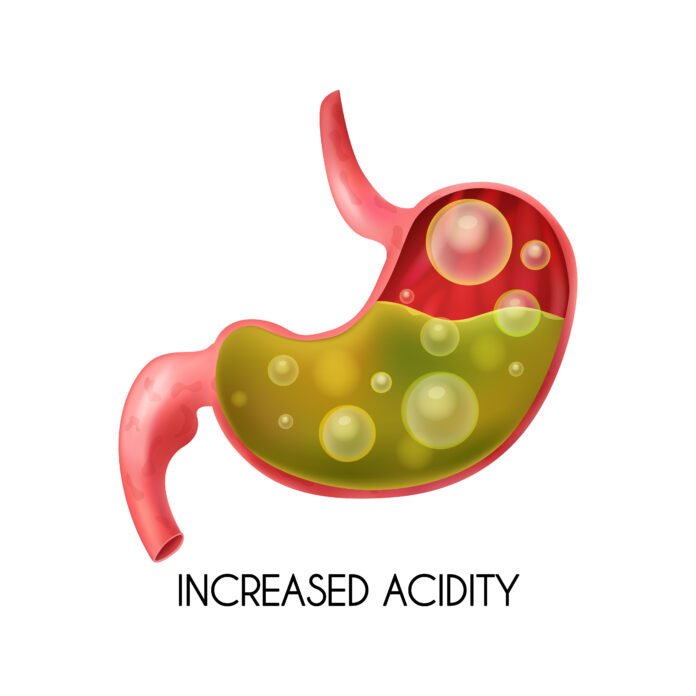Are you habitual of lying down soon after dinner? If yes, you’re at the verge of chaos because lying down after eating a rich lager meal can cause Acid Reflux and GERD. Undigested food makes stomach acids in large quantities that raises its level in your esophagus leading to the appearance of indigestion like heartburn. The acid reflux is categorized into two types, the occasional acid reflux can be managed at home but the chronic one known as GERD cannot be treated at home. It might need medical assistance. If left untreated, GERD can cause damage to your gut tissues especially esophagus.
What is Acid Reflux?
When you eat food. It travels only one way i.e down to wards stomach, intestine and further. This movement is supposed to be one way always but sometimes stomach acid secreted from stomach wall lining starts to travel backward meaning upside down in the esophagus and throat. This is acid reflux. The acid is not suitable for the parts of the alimentary canal other than the stomach. Therefore, when it comes out of the stomach, you feel its presence in your esophagus and throat. It not only irritates your esophagus tissues but also produces inflaming sensations there. It also inflames your stomach up to your chest and throat.
No doubt, almost everyone has experienced the occasional acid reflux in their life span because it usually feels like a stomach problem, including heartburn, indigestion, or chest pain near your sternum.
In addition, occasional acid reflux makes your gut uncomfortable and irritating but it is manageable without seeking medical help. According to studies,it is not a disease or health problem but it may cause damage to your alimentary canal and affect your quality of life.
What is GERD?
Gastroesophageal reflux disease is commonly known as GERD. In some countries, people pronounce it as GORD. GERD is a chronic form of acid reflux in your esophagus. But to confirm it is a GERD or occasional acid flux, time for which it lasts ,matters. If the acid reflux symptoms occur two to three times a week for more than a month, it will be chronic acid reflux, i.e. GERD.
In addition, GERD isn’t a temporary experience. It is declared as a constant, mechanical problem in the human body. The word mechanical explains that the mechanism to keep acid restricted to your stomach is not working well.
Is Acid Reflux and GERD a Common Illness?
Occasional, temporary gastroesophageal reflux and GERD (esophageal reflux disease) both are common. While GERD is affecting people in the country more than occasional acid reflux.
Symptoms of Acid Reflux and GERD
Common symptoms of acid reflux include:
Back Wash: This resembles regurgitation. Somehow it is actually regurgitation. You may experience liquids or food particles back-washing from your stomach into your esophagus or throat after eating. You may feel the sour taste of acid along with food and liquid.
Burning Sensation: Acid coming from the stomach burns the tissues in the lining of your esophagus. When the burning sensation reaches your chest,it is called heartburn. Sometimes it is closer to your stomach and known as acid indigestion.
Non-Cardiac Chest Pain: Esophagus is near to the heart and pain in the esophagus often triggers the pain in the nerves same as heart-related pain in the chest. This pain is different from the burning sensation. Therefore often people confuse it with heart pain and go to a cardiologist for a proper diagnosis.
Lump in Throat: Your throat becomes sore due to rise in acid content. A sore throat often feels like a lump in your throat. You may also feel it is difficult to swallow. The lump may feel more intense at night.
Nausea: It is the common symptom that occurs due to backwash or overflow which makes you feel queasy or make you lose your appetite.Sometimes, you feel more food to digest, even if you ate a while ago.
Symptoms of GERD include:
Asthma: GERD triggers asthma-like symptoms, including shortness of breath, coughing and wheezing. Entering acid drops into your airways causes contraction in them. This is the leading cause of asthma-like symptoms.
GERD is also diagnosed by the symptoms jotted below:
- Suffocation after bending over.
- Nausea after a large meal at night.
- Chest pain while lying down at night.
- Shortness of breath after drinking alcohol and smoking.
Causes of Acid Reflux
Food from the stomach enter your esophagus after passing through the valve past the bottom of your esophagus. This valve keeps things from coming back to the esophagus in normal conditions. But acid reflux makes it useless and the valve that is known as lower esophagus sphincter opens for backwash. It resembles anti-peristalsis.
In addition, the lower esophagus sphincter actually opens when you swallow and closes when you swallow. During this movement, it often lets gas bubbles out that is known as burping. When your valve of the esophagus weakens it lets the acid enter the esophagus. A common factor that makes your LES weaken or relax is lying down after a large meal. Persisting or prolonged relaxation of LES turns occasional acid reflux into chronic GERD.
Common causes of Acid Reflux and GERD include:
Smoking: Smoking or second-hand smoking both are the major factors of relaxing LES. smoking tobacco products triggers chronic coughing leading to opening of LES. coughing and continuous smoking weaken your diaphragm muscles leading to developing hiatal hernia. Smoking also causes more acid production in the stomach that leads to indigestion.
Pregnancy: In pregnancy, the pressure and volume of your abdomen increases that stretches and weakens your diaphragm muscles. In this way your LES gets weakened during pregnancy. That’s why pregnancy is considered the common cause of acid reflux. Moreover, during pregnancy, your body releases a great quantity of relaxing hormones to help relax your muscles to make room for the fetus. Along with relaxing, a higher amount of estrogen and progesterone hormones also released that causes the opening of LES.
Obesity: Similar to pregnancy, obesity also causes higher pressure and stretching of diaphragm muscles due to being overweight. Obesity also lasts for longer than pregnancy. This weakens your muscles permanently leading to hiatal hernia.
Hiatal Hernia: This happens when the upper part of your stomach pushes towards the hole of the esophagus. Overlapping of top of stomach and esophagus causes compressing and squeezing of both. This thing moves your LES on your diaphragm and traps the acid. In this way LES loses its muscular elasticity. Hiatal hernia usually occurs in old age and gradually worsen.
More possible causes of GERD include:
Birth Defects: Certain congenital defects, such as atresia and hernias cause relaxing LES.
Connective Tissue Disease: Certain skin diseases like scleroderma,affect your LES and esophagus muscles.
Medications: Certain relaxing medications affect your esophagus muscles.
Prior Surgery: Surgery in your upper abdomen and chest sometimes injures your esophagus that causes stretching of LES.
Can Food Cause Acid Reflux?
If you’re thinking that only foods and drinks are the cause of acid reflux, you’re wrong. Oily food or drinks can’t cause the condition. But they are contributors in its development. Yes, if you’re fond of coffee, alcohol, chocolate.onions, garlic, or mint and consume these things in excess/quantity, you’re making your LES more relaxed.
In addition, Certain fatty foods also play a role in increasing acid accumulation in your stomach. These things also take a longer time for digestion . So the acid gets more time to escape. Moreover, having a hearty meal as dinner and lying down soon after eating, your stomach doesn’t find enough time to digest the food. These factors treating styles can increase risk of acid reflux or GERD.
Possible Complications related to Chronic Acid Reflux
Stomach has strong chemicals that can break your food so that you easily digest it. Thus stomach acid actually helps you in digestion. But the acid in the stomach doesn’t affect the stomach walls. Because there is a thick and tough inner lining of special substance on your stomach walls that protects stomach walls from acid activity. But your other organs don’t have such a protective layer against acid. Therefore, when your stomach acid reaches other organs of the alimentary canal, it harms them. For example when the acid reaches your esophagus or windpipe, it causes inflammation and burning sensation there. You feel uncomfortable momentarily but if the acid is in large quantities it will damage the organs permanently.
More complications include:
Esophagitis: When acid reaches your esophagus, it causes inflammation in its lining that leads to chronic pain. If it is left untreated it can cause more severe complications such as ulcers in your esophagus. Afterwards it converts into scarring causing tissue damage or intestinal metaplasia. The condition is known as precancerous stage.
Barrett’s Esophagus: Intestinal metaplasia of your esophagus is also named as Barrett’s esophagus. This is called because in this condition the tissues found in the inner lining of your esophagus look like tissue present in the lining of the intestine. This is done due to long term exposure to acid and inflammation. It can be the leading cause of oesophageal cancer .
Oesophageal Stricture: Acid also causes damage to scar tissue in oesophagus which it has developed to protect itself from chronic inflammation. Scar tissues make your esophagus injured and narrower. The condition is called structure which makes it hard for youtube swallow, eat or drink.
Laryngopharyngeal Reflux: This condition affects your throat. It happens when acid sneaks up into your throat while you sleep. People who have GERD often complain about LPR at night. LPR causes abnormal growths, swelling and hoarseness in the vocal cord. Sometimes, acid particles also are aspirated into your airways.
Asthma: This condition occurs when acid gets into your airways and enhances the effects of asthma or asthma-like symptoms. This condition often affects the patients who are already patients of asthma but sometimes it also affects those who don’t have any pre-existing respiratory disorder. In this condition, tiny acid droplets irritate your airways, including bronchial tubes and alveoli leading to contraction of air tubes. That’s why people experience severe difficulty in breathing and coughing.
Diagnosis of GERD
First of all your oesophagus is examined thoroughly, whenever you go to diagnose GERD. Different tests for diagnosing GERD include:
Esophagram: This is a type of X-ray that is also known as fluoroscopy. It takes moving images of your esophagus when food particles are passing through it. To indicate the path of food in the oesophagus, you have to swallow a chalky liquid called barium.
Upper Endoscopy: Through this test, doctors put a tiny camera inside your oesophagus and then take a closer look inside your oesophagus. The camera is inserted through a thin tube into your throat while you’re sleeping under light sedation.
Treatment Options for Acid Reflux and GERD
Healthcare professionals usually encourage the approach to reduce acid reflux with changing your lifestyle including losing weight, reducing use of tobacco and alcohol and changing eating habits. But sometimes, these ordinary changes do not work and symptoms get worse over time. This is the sign that you have GERD. your acid reflux disorder has been converted to GERD. Now, you have to take medications to limit the acid production in your stomach . So that the damage caused by acid reflux can be reduced. Common medications for GERD are jotted below. These are easily available.
Antacids: This medicine neutralizes the avidity in your stomach. Therefore, after taking this medicine the reflux isn’t as corrosive as before. Occasional acid reflux can be treated with such medications but they also have some side effects and are not safe for long-term use.
Alginates: These naturally occurring sugars are extracted from seaweed. They are effective for blocking acid reflux. They create a physical barrier between your esophagus and acid. Combination of antacids and alginates is considered more effective to stop acid reflux.
Proton Pump Inhibitors: They are stronger substances that create blockage in the path of acid that also helps in healing. In case of severe tissue damage due to GERD, doctors often prescribe these medications. This medicine is the most effective for reducing acid reflux. That’s why it is considered as first line treatment for GERD.
Conclusion
Acid reflux is a common health condition that is experienced by almost every one around the world. Its common symptoms are heat burn, acid regurgitation, and indigestion that makes night sleep like a nightmare for you. Frequency of acid reflux can be reduced by some ordinary means. But if it happens more frequently and intensity of symptoms gets worse over time, it might be GERD. It’s time to consult a doctor. Inform them about all symptoms completely,so that they may help you assess which treatment will help you.







